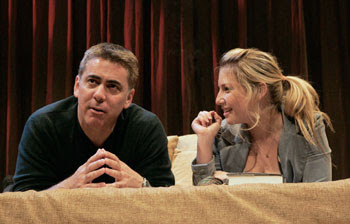New York. Boston. Seattle. L.A.: Lately, our commissioned plays are turning up everywhere! Since 1985, SCR has awarded more than 241 commissions to 153 playwrights. We commission between 8 and 12 plays each year, which is, to our knowledge, higher than any other theatre company in the U.S. For those not familiar with the term, a “commission” means that we pay a writer to create a play for us. We then get the right to produce it first, which we sometimes do and sometimes don’t.
Over the years, scores of SCR commissions, including Richard Greenberg’s Three Days of Rain (1997) and David Lindsay-Abaire’s Pulitizer-Prize wining Rabbit Hole (1997), went on to be produced at other theatres. Now, these four are making headlines:
- Lascivious Something was first commissioned by SCR in 2002. It centers around an American and his young Greek bride who escape to an island and plant a small vineyard. Since 2002, Sheila Callaghan’s play has been workshopped at the Bay Area Playwright's Festival and was developed with Soho Rep. Circle X Theatre Co. in L.A. will begin performances on March 27. A little more than a month later, The Women’s Project and Cherry Lane Theater in New York will begin performances on May 2.
- Brooklyn Boy first premiered at SCR in September 2004. It was co-produced with Manhattan Theatre Club and performed at its Biltmore Theatre in February 2005. Taproot Theatre Company in Seattle will now continue its 34th season in March with Brooklyn Boy. The playwright, Donald Margulies, was also commissioned to write SCR’s Time Stands Still (2009), Shipwrecked! An Entertainment (2007), Sight Unseen (1991) and Collected Stories (1996). Sight Unseen and Collected Stories were both finalists for the Pulitzer Prize for Drama.
- The Luck of the Irish was first commissioned by SCR in 2006. The playwright, Kirsten Greenidge, decided she was going to write at the age of 12 after seeing August Wilson’s Joe Turner’s Come and Gone. August Wilson also wrote Fences, which was on the Segerstrom Stage this season. The Luck of the Irish was further developed by Huntington Theatre Company in Boston with support by the NEA New Play Development Program. It is about two sisters who invite a long time friend of the family's to a memorial picnic for their grandmother. They learn that the deed to the house their family has called home for decades is being mysteriously “reclaimed.”
Read a recent interview with Kristen Greenidge
- Sunlight was also commissioned by SCR in 2006. Written by Sharr White, this play just ended its run at the Phoenix Theatre in Indianapolis and will continue its run at the ArtsWest Playhouse in Seattle until April. New Jersey Repertory Co. will begin performances in July. It is about Matthew Gibbon, a liberal lion and a university president, who may have gone too far in his battle against the conservative dean of the law school—his son-in-law and former protégé.
Read a recent interview with Orange County native Sharr White





 Phillip Vaden with Jane Carr in Habeas Corpus in 2004.
Phillip Vaden with Jane Carr in Habeas Corpus in 2004.